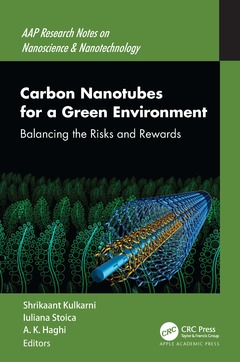Carbon Nanotubes for a Green Environment Balancing the Risks and Rewards AAP Research Notes on Nanoscience and Nanotechnology Series
Coordonnateurs : Kulkarni Shrikaant, Stoica Iuliana, Haghi A. K.

Carbon Nanotubes for a Green Environment: Balancing the Risks and Rewards describes the synthesis, characterization, and unique applications of undoped and doped carbon nanotubes as well as hybrids of them with grapheme or nanocomposites, focusing on green aspects of carbon nanotube applications. The volume shows new approaches used for tapping the potential and promise of key materials in isolation or combined with other materials.
The research-oriented chapters highlight a spectrum of applications of carbon nanotubes as novel materials for energy storage as well as for environmental remediation, wastewater treatment, green health care products, and more. Chapters explore the use of carbon nanotubes for remediation methods for wastewater treatment such as by using graphene oxide-carbon nanotube composites and by applying undoped and doped carbon nanotubes for removing contaminates. The book also looks at the application of carbon nanotubes for enhanced oil recovery and for heavy metal separation. Other chapters look at the rheological behavior of carbon nanotubes-based materials and their role in processing for various products, the thermal and electrical transport in carbon nanotubes composites, carbon nanotubes-based composite materials for electromagnetic shielding applications. The biomedical applications of carbon nanotube-based nanomaterials also explored, such as FTIR spectroscopy.
1. Carbon Nanotubes for Clean Water 2. Graphene Oxide-Carbon Nanotube Composites for Wastewater Treatment 3. Undoped and Doped Carbon Nanotubes for Remediation of Contaminants from Wastewater 4. An Overview of the Application of Carbon Nanotubes for Enhanced Oil Recovery (EOR) and Carbon Sequestration 5. Carbon Nanomaterial Embedded Membranes for Heavy Metal Separation 6. Carbon Nanotubes for Biomedical Applications 7. Carbon Nanotubes for Greening the Environment 8. Rheological Behavior of Carbon Nanotubes-Based Materials and Its Role in Processing into Various Products 9. Thermal and Electrical Transport in Carbon Nanotubes Composites 10. FTIR Spectroscopy for Carbon Nanotube-Based Nanomaterials in Biomedical Applications 11. Carbon Nanotubes-Based Composite Materials for Electromagnetic Shielding Applications 12. Carbon Nanotube-Based Nanocomposites: Promising Materials for Advanced Biomedical Applications
Shrikaant Kulkarni, PhD, has 37 years of teaching and research experience at both undergraduate and postgraduate levels. He is an adjunct professor at Vishwakarma University, Pune, India. He was formerly Professor in the Department of Civil Engineering, Padm. Dr. V. B. Kolte College of Engineering, Malkapur (M.S.), India. He has been teaching subjects such as engineering chemistry, green chemistry, nanotechnology, analytical chemistry, catalysis, chemical engineering materials, industrial organization, and management, to name a few, over the years. He has published over 100 research papers in national and international journals and conferences. He has authored 18 book chapters in CRC, Springer, and Elsevier books. He has edited two books in green engineering and renewable materials from Apple Academic Press/CRC Press. Another three books—on carbon nanotubes for green environment and carbon-based nanomaterials for energy storage and artificial intelligence for chemical sciences—are in the process of development. He has coauthored four textbooks on chemistry as well. His areas of interests are analytical and green and sustainable chemistry. He is a reviewer and editorial board member of many journals in green and analytical chemistry. He has been invited by UNESCO to give a talk on "Green Chemistry Education for Sustainable Development" at the IUPAC international conference on green chemistry held at Bangkok (Thailand) in September 2018, which was well received. He is an esteemed team member of United Nations Conference on Sustainable Development (UNCSD) working for the attainment of sustainable development goals. He was appointed as an innovation summit judge in a Conrad challenge competition for teams from across the world, sponsored by NASA. He has been instrumental in formulating and coordinating RIO & COP programs dedicated to sustainable development at his institute by UNCSD. He has worked as a resource person for various national and in
Date de parution : 06-2022
15.2x22.9 cm
Disponible chez l'éditeur (délai d'approvisionnement : 14 jours).
Prix indicatif 161,46 €
Ajouter au panierThèmes de Carbon Nanotubes for a Green Environment :
Mots-clés :
CNTs; Multiwalled CNTs; Percolation Threshold; Single Walled CNTs; Multi-walled CNTs; CNTs Composite; Microbial Fuel Cells; MWCNTs Loading; CNT Nanofluids; Go; Mm Membrane; Percolation Point; Tissue Engineering; Nitrogen Dope CNTs; PVP Hydrogel; Electromagnetic Radiation Shielding; SEM; Carbon Nanofiber; CNTs Amount; Amide Ii; Environmental Engineering Science; Carbon Nanohorns; Non-linear Viscoelastic; FTIR Spectrum; Oil Recovery Experiments



